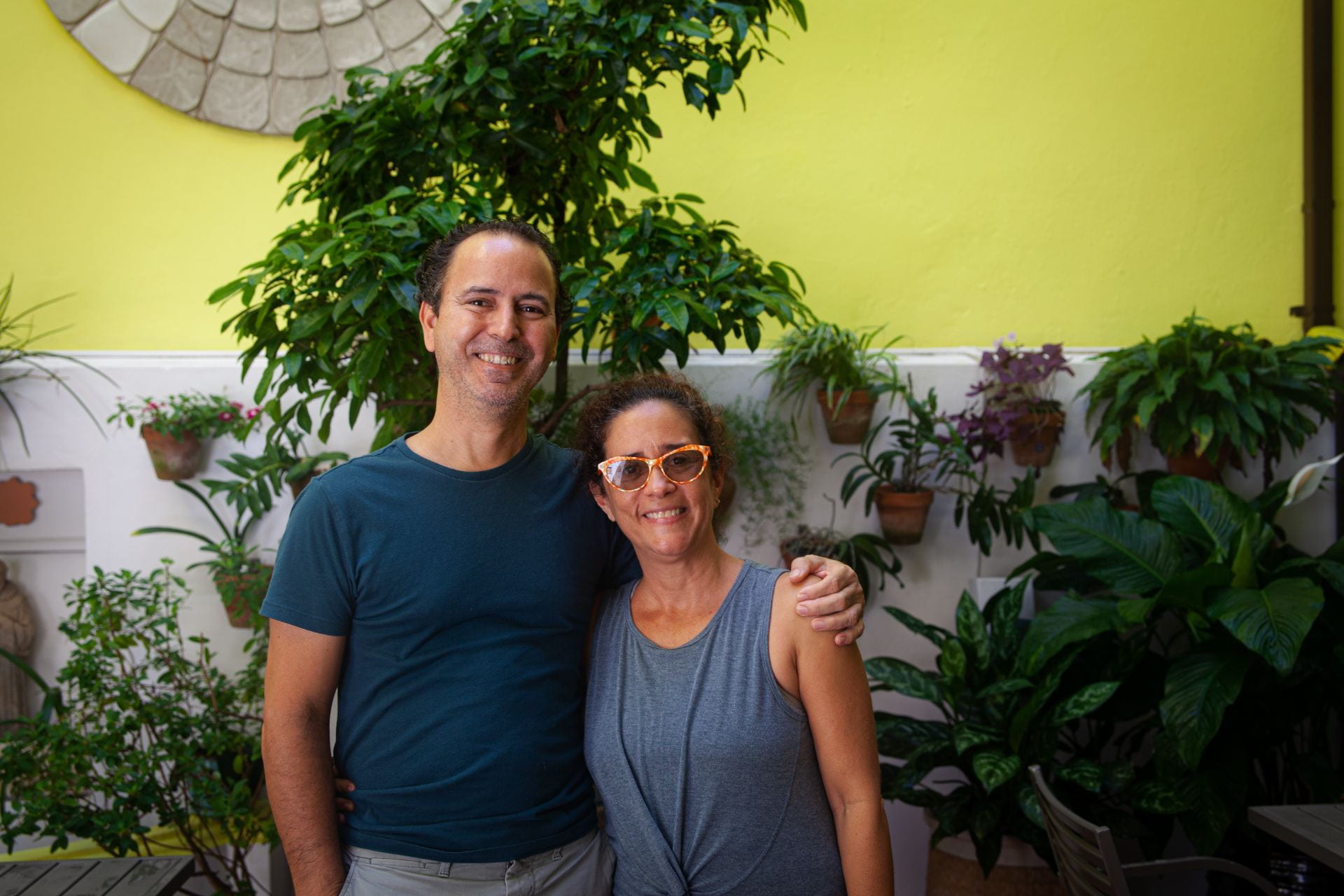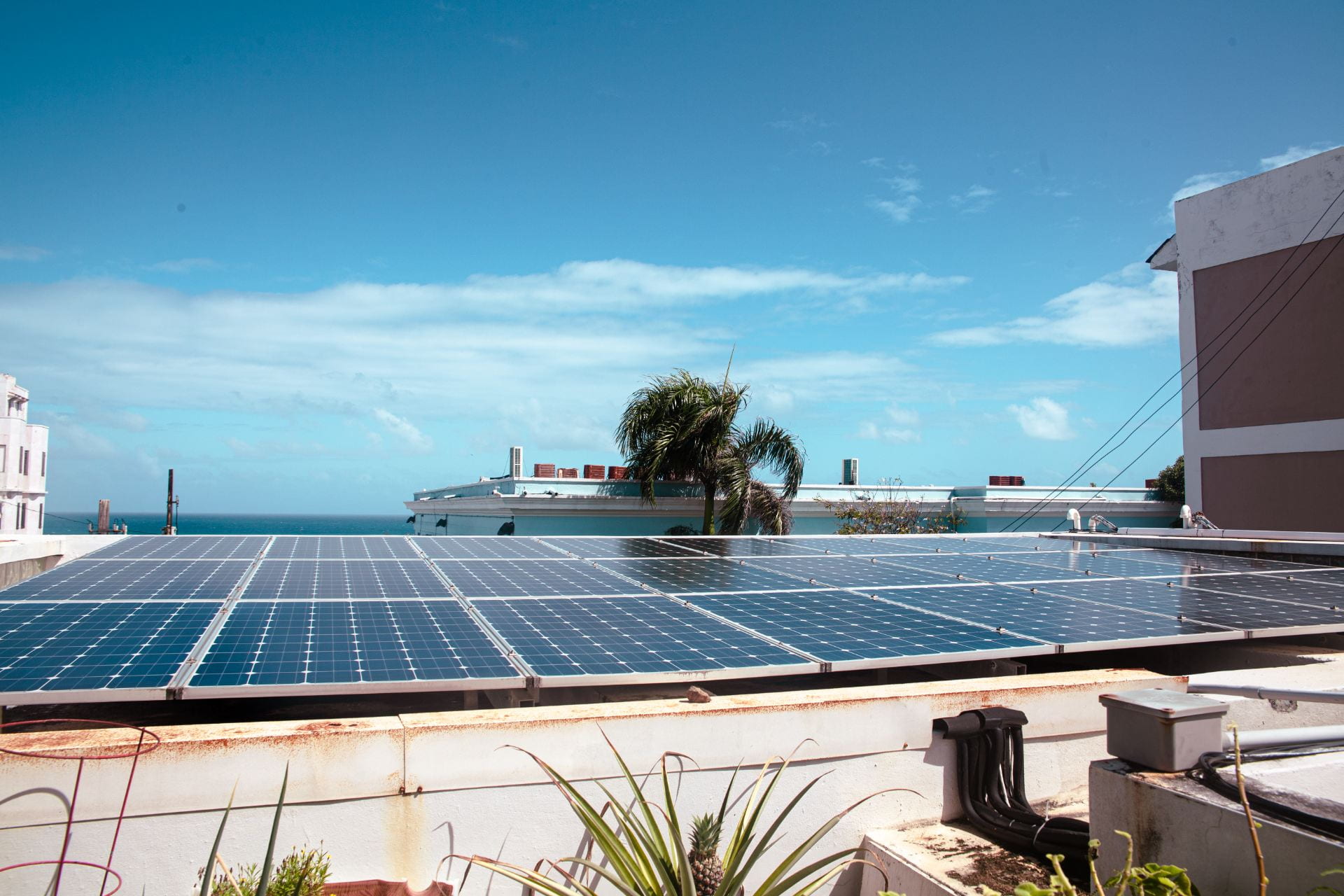
Photo by Elisabeth Hadjis | On the roof of Casa Sol, a bed and breakfast in Old San Juan, owners Eddie Ramírez and Tisha Pastor have installed 30 solar panels to power their hotel.
By Elisabeth Hadjis
SAN JUAN, Puerto Rico ⏤ Gathered in a plaza at the heart of the University of Puerto Rico’s Río Piedras campus, an ensemble of theater students sing, dance and recite lines in Spanish. The university’s iconic clock tower, nicknamed La Torre, casts shade on the group as a band cues the actors with the sound of drums.
The students are members of a travelling drama club called El Teatro Rodante Universitario. In the dry March heat, they’re practicing for a production of Federico García Lorca’s “La Zapatera Prodigiosa” — “The Prodigious Shoemaker” — which they plan to put on throughout April and May, along with a special performance in Spain next October.
With opening night in sight, this rehearsal is an important one — but it almost didn’t happen. That’s because three days before, an issue with one of two electrical substations in the area caused a widespread power outage to the university, forcing the school to close and move courses online.
“I mean, for assignments, I need the internet and electricity. And I work here at the university. If there is no electricity, I can’t work, I don’t get paid,” said Jhansis Ramos Lopez, a sixth-year acting and communications student at UPR, and the publicist for “La Zapatera Prodigiosa.” Electrical issues, he says, have meant that rehearsals — which typically take place at night — are re-scheduled during the day to take advantage of the sunlight and avoid the obstacles posed by a power cut.
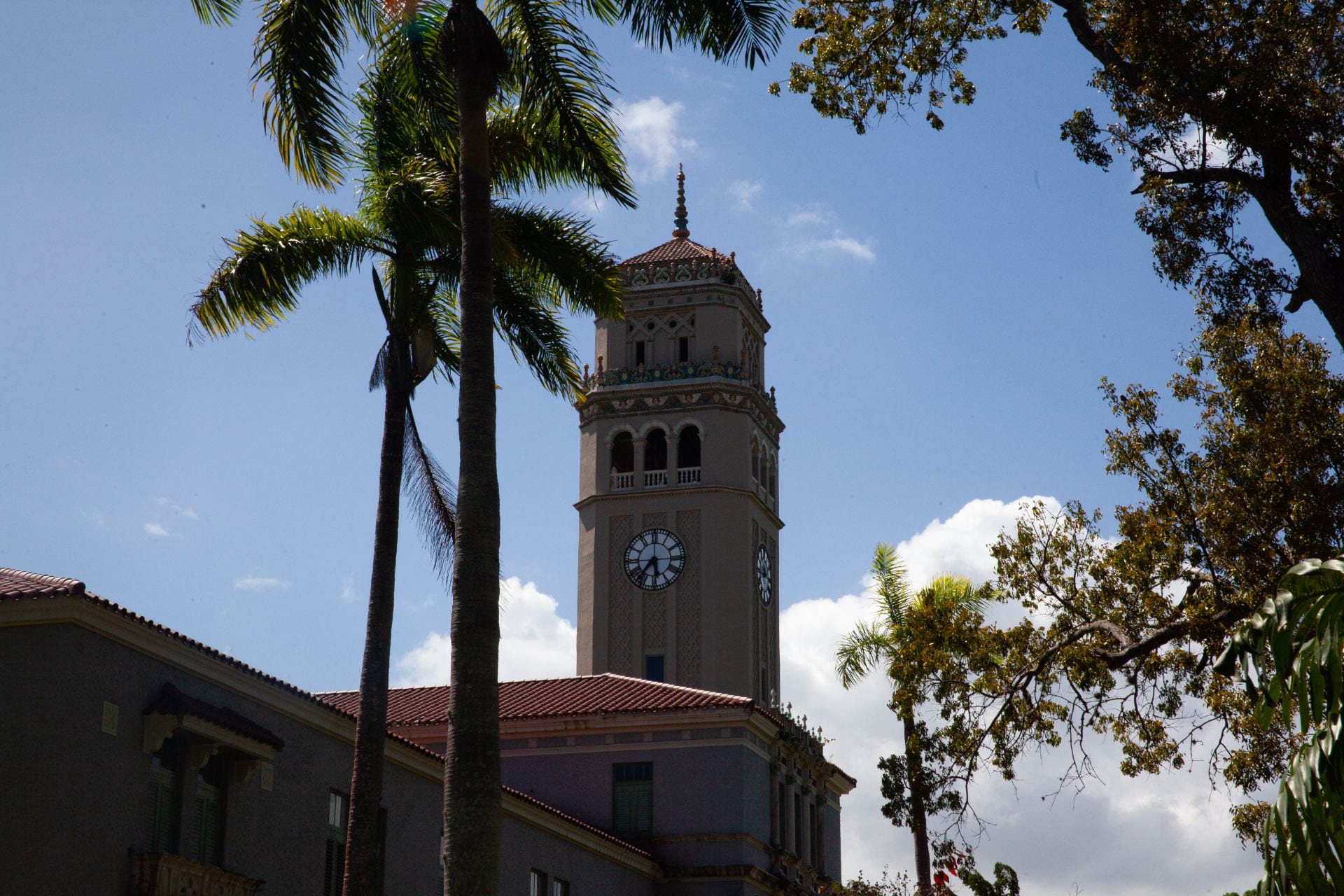
Photo by Elisabeth Hadjis | A historic clock tower marks the heart of campus at the University of Puerto Rico’s Rio Piedras location. Students typically gather in the plaza here, but when the power went out in early April, the campus was empty, forced to close and move classes online.
Puerto Rico’s energy access issues aren’t isolated to the Río Piedras university campus. Across the island, communities have endured the pains of an unreliable power grid for years, but a series of natural disasters has brought renewed attention to the issue. Hurricanes Irma and Maria, which made landfall in September 2017, caused the largest blackout in United States history and left many of Puerto Rico’s 3.3 million residents without electricity for as long as a year.
Access to reliable electricity hasn’t improved much since then, with power outages still occurring regularly, usually caused by failures in the territory’s outdated energy infrastructure. Just this April, a fire at one of Puerto Rico’s major power plants caused a four-day, island-wide blackout impacting over 1 million people.
In the years following the hurricanes, as Puerto Ricans search for trustworthy electricity, power generators have become essential for those who can afford it. But experts on the island believe there may be a better way to achieve energy resilience — one that’s much cleaner, greener and more reliable. The solution, they say, can be found in the sun.
Jorge Colón Rivera is a professor of chemistry at the University of Puerto Rico in San Juan whose research focuses on solar and renewable energy. He says solar power is the future of the territory, boosting its resilience to major storm events and to daily energy failures caused by weak infrastructure.
“We get a lot of small blackouts around different towns almost every day,” Colón said. “Solar provides us the opportunity of not having to experience what we experienced after Hurricane Maria. We lost all power on the island and the only places that remained with power were the places that had solar panels.”

Photo by National Oceanic and Atmospheric Administration | Satellite images show the state of Puerto Rico’s access to power before and after Hurricane Maria in 2017. The storm left millions without power, some of them for up to a year.
When it comes to monthly bills, energy from the sun also happens to be much more affordable than the traditional grid. In 2021, with an energy model that relies on fossil fuels for 97% of its power generation, the average Puerto Rican spent 22 cents for every kilowatt hour of energy used — 12 cents more than the average cost on the mainland. With solar, households could pay only a fraction of that, with rates lowered to 15 cents per kilowatt hour.
From Colón’s perspective, more significant than the cost decrease is solar’s ability to decentralize the island’s energy system, giving Puerto Ricans control over their electricity and putting power back in the hands of the people — literally.
“Part of the problem that happened in the Maria disaster was that since everything was so centralized, if something was damaged in one part of the grid, there wasn’t the possibility to really isolate the other parts, so everything got messed up,” said Colón. “[With solar power,] we can get people to generate their own electricity in a system managed by local energy authorities.”
This concept is the basis for Queremos Sol, a February 2020 proposal published by a network of stakeholders and industry professionals — including the Sierra Club of Puerto Rico and the Institute for Energy Economics and Financial Analysis. The proposal puts forward a new model for energy in Puerto Rico — one where ownership over electrical systems falls to local communities, organizations and even individuals.
Although it has yet to be adopted by the Puerto Rican Energy Bureau, or PREB — the regulatory body that oversees the implementation of energy policy on the island — some forward-thinking Puerto Ricans are taking steps on their own to make solar energy happen.
Arturo Massol-Deyá is a professor of biology at the University of Puerto Rico in Mayaguëz and, as a collaborator on the Queremos Sol document, is one of the island’s most vocal advocates for solar power. He thinks the territory can do more with the sun — a resource that is in no short supply in the Caribbean.
“If you place some solar panels in one third or maybe less than half of the surfaces that are already built in Puerto Rico, you can get 100 percent of the energy needed,” Massol said. “The potential is out there.”
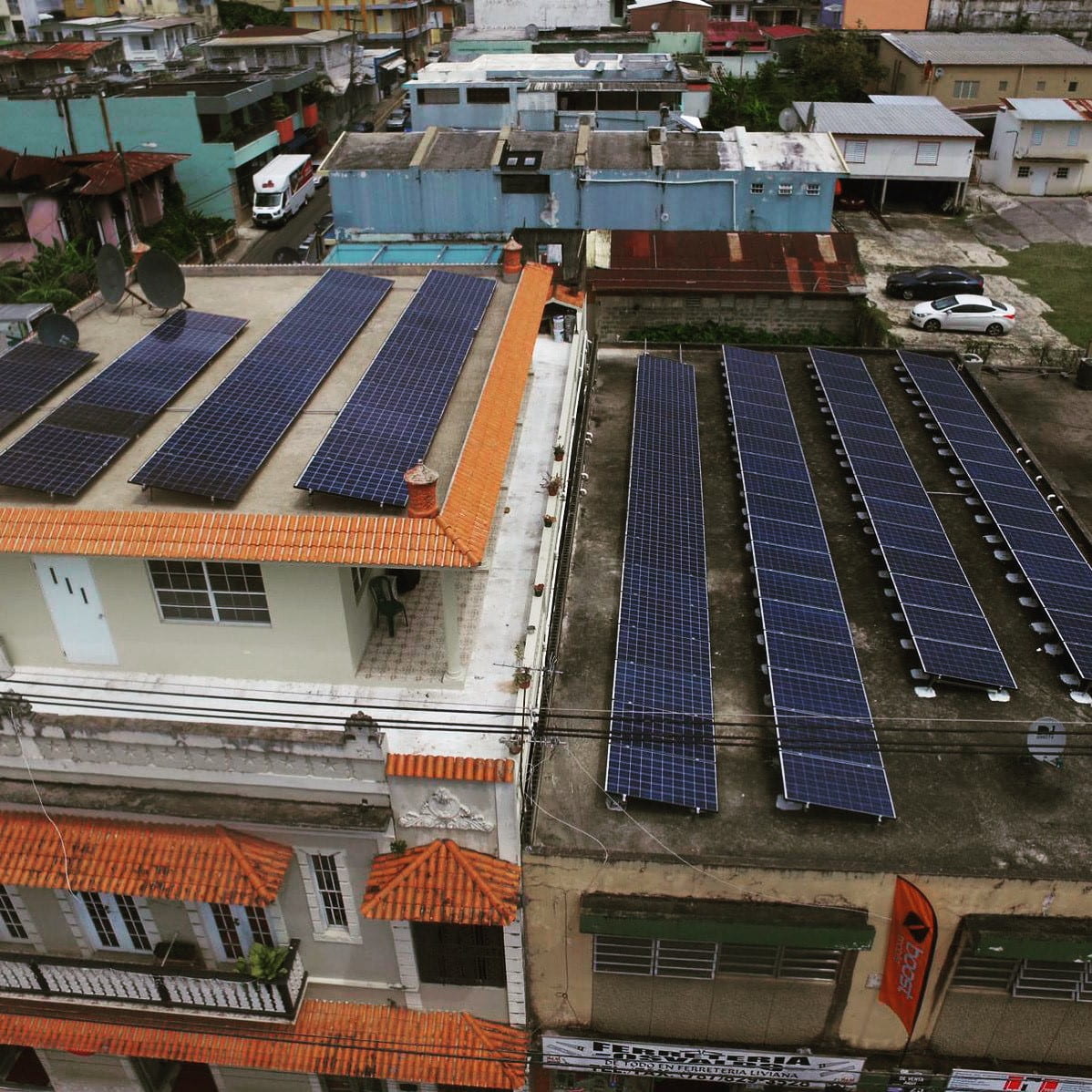
Photo by Casa Pueblo | Roughly 2000 solar panels – installed by environmental group Casa Pueblo – adorn the roofs of businesses, homes, community centers and more in the town of Adjuntas.
In fact, the number is much greater than 100 percent. Recent analysis shows that building solar infrastructure on Puerto Rico’s existing rooftops alone can supply roughly four times the energy needed to power all of the island’s residential needs.
Massol knows this well. Outside of his work at the university, he serves as the assistant executive director for Casa Pueblo — a community-based environmental organization based in the rural mountain town of Adjuntas, known for its coffee plantations. The organization, whose main focus is the promotion of sustainable local development, is a leader in Puerto Rican solar energy production, generating over 200 kilowatts every year. They were going solar before anyone else on the island, installing their first panels in 1999 and becoming almost entirely solar-dependent after the hurricanes in 2017. With 45 solar panels of their own and nearly 2000 more located across the town, Casa Pueblo now supplies enough energy to sustain the majority of Adjuntas — everything from a cinema and a radio station to grocery stores, homes, schools and fire stations.
“What we are doing is transforming the energy landscape of critical components of our society — houses, critical infrastructure for economic activity, support for food security and agriculture,” said Massol. “The reason that we’re doing this is to build up a reference of what can be done in other municipalities in Puerto Rico. We’re going to change the energy landscape in Adjuntas and that means that it can be done everywhere.”
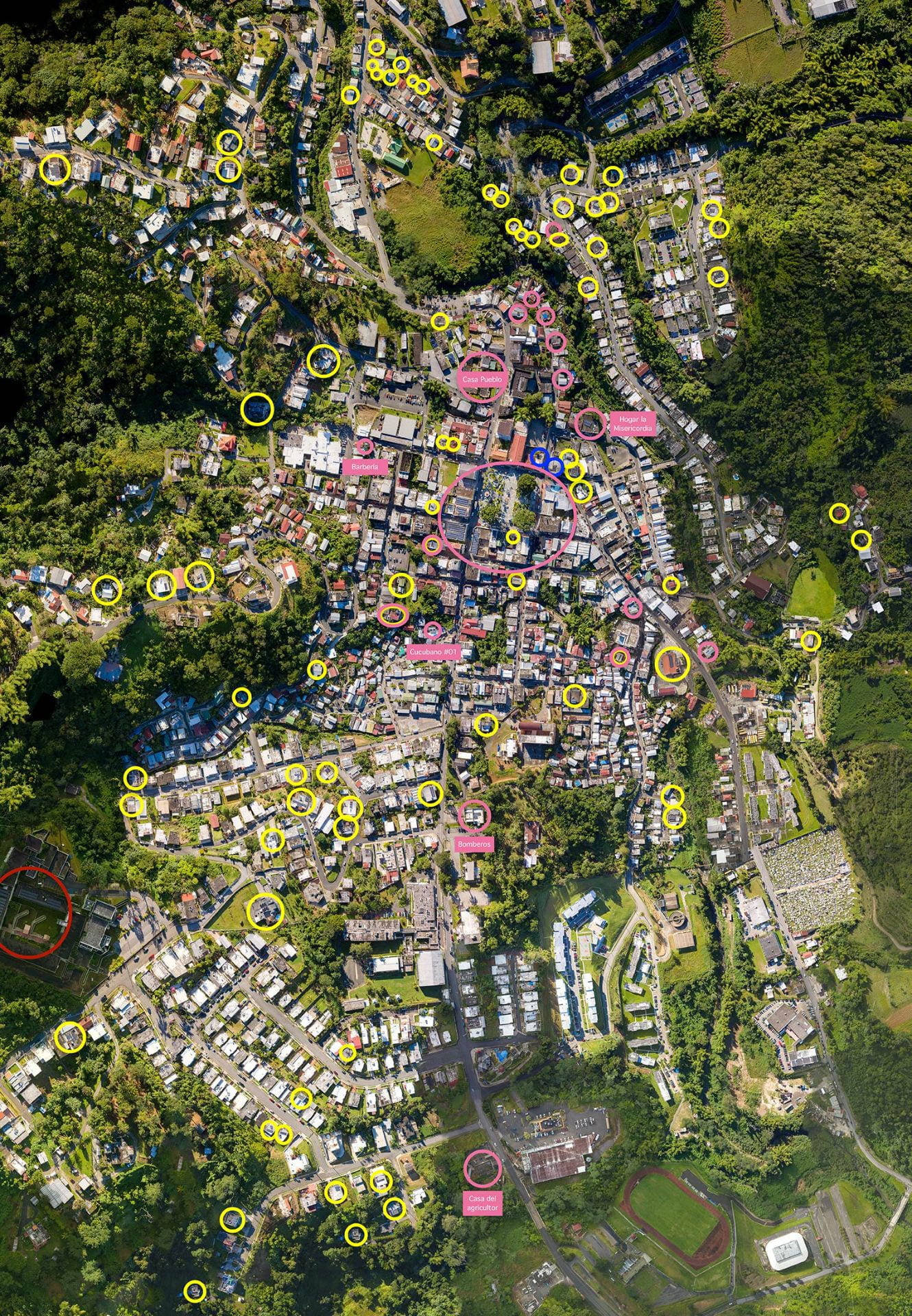
Photo by Casa Pueblo | A birds-eye-view photo of the town of Adjuntas from 2021 shows some of the area’s solar power systems. Pink circles mark solar projects carried out by community self-management, blue circles are government installations, red circles are by the Red Cross and yellow circles are independent installations. Casa Pueblo hopes to continue expanding, utilizing empty rooftops to bring power to the region.
And “everywhere” is the goal for Puerto Rico’s administration, too — on paper, at least.
In February, the United States government partnered with the Commonwealth of Puerto Rico to launch the Puerto Rico Grid Resilience and Transitions to 100% Renewable Energy Study, or PR100. The initiative — backed by a $12 billion check from the U.S. Federal Emergency Management Agency designated for post-hurricane electrical recovery — promises to help the territory achieve its energy targets, which include running wholly on renewable energy by 2050, as set forth by the Puerto Rico Public Policy Act, or Act 17.
This is a promise that some energy experts are wary to accept.
“I have heard the same story for the last 2 and a half years. ‘The money is coming,’” said Ralph Kreil Rivera, an electrical engineer and the former chairman of the Puerto Rico Electric Power Authority’s governing board, who resigned in January 2021. “The money that’s coming in won’t even fix the entire grid. It’s going for the most important places, like hospitals or first responders.”
When the money does come, solar advocates like Colón worry that it won’t be properly distributed. Although some renewable energy projects have been approved by the oversight committee for energy — the Puerto Rico Energy Board, or PREB — many of them require installing solar farms or other large-area projects, which take up valuable agricultural space and can be harmful to the environment. Even with these initiatives in the works, Colón warns that Puerto Rico is far behind on attaining its own energy goals.
“Even though we have this law that we are supposed to get 100% [renewables] by 2050, we are not near the correct pathway to reach those targets,” he said. “I believe that’s because the ‘fossil fuel cartel,’ as we sometimes call them, is so strong that they have convinced the government and power generation agency that they should still rely on building more natural gas installations.”
Among Puerto Ricans, there are also concerns related to transparency, compliance and the government’s management of these important funds. This was solidified in June 2021, when private energy company LUMA signed a 15-year agreement with the territory to take over energy operation from the Puerto Rican Electric Power Authority, or PREPA, a bankrupt government utility. PREPA had a widely reported history with debt and suspected corruption — something that many Puerto Ricans feel will transfer to LUMA as this transition to privatized energy begins.
Kreil doesn’t feel that this is the case, citing bureaucracy as the obstacle getting in the way of the island’s renewable energy projects. “I do not feel that there is mismanagement involved. Everybody’s watching for transparency,” he said.
In the meantime, while Puerto Ricans wait for territory-level energy solutions from PREPA, PREB and LUMA, individually-commissioned solar projects are proving their worth.
Eddie Ramírez and his wife Tisha Pastor are the owners of Casa Sol, a small, sustainable bed-and-breakfast in Old San Juan. With their business, they’re hoping to prove that independence from the energy grid is not only possible, but profitable. That doesn’t mean that getting there is cheap.
When the couple planned to open their own hotel business in 2012, Ramírez, who has worked in sustainable hospitality for over 20 years, knew he wanted to run on solar power. At that time, Casa Sol’s entire system of 30 panels — from the purchase to their installation — cost the Pastors roughly $30,000. Nearly half of that, Ramírez recalled, pays for the essential batteries that store the solar-generated energy.
When discussing with friends their plans to go off the grid for their bed-and-breakfast project, Ramírez and Pastor were met with confusion. At that price, solar power didn’t seem worth it. The panels themselves are inconspicuous, installed on the roof, next to the couple’s herb garden, facing the sea. But a few years later, when two hurricanes hit the island, the Pastors’ solar energy proved to be more valuable than they could have imagined.
When Hurricane Maria hit, Ramírez and Pastor were able to help their neighbors keep medicines in their refrigerator. They supplied them with power to charge their laptops and phones. The hotel became a hub for first responders who needed electricity to recharge after long rescue days. Eventually, by purchasing more panels and connecting them to their neighbors’ generators, the couple was able to build a nearly 50-panel microgrid to fully support their community when no one else – the mayor of San Juan, the president of the United States – could.
“People don’t believe until they see things. To be able for three months to be the only property on this island of Old San Juan with power,” said Ramírez, sitting in a wooden rocking chair in the bed-and-breakfast’s back office. “Believe me, it paid off 100 times.”
Photos by Elisabeth Hadjis (in order) | Eddie Ramírez and Tisha Pastor pose in the lobby of Casa Sol, their sustainable bed-and-breakfast in Old San Juan; on the roof of Casa Sol, a bed and breakfast in Old San Juan, owners Eddie Ramírez and Tisha Pastor have installed 30 solar panels to power their hotel; sign inside Casa Sol.
Today, the solar power market in Puerto Rico looks much different than it did when Eddie and Tisha first had their system installed. In the aftermath of the hurricane, dozens of businesses specializing in solar energy products have emerged, primarily in service to residential electricity systems. Though over 75% of the solar market in Puerto Rico is controlled by Texas-based contractors Sunnova Energy, local industry is experiencing a boost too. Residents looking to install solar panels now have an array of Puerto Rican solar suppliers to choose from, such as Integrated Solar Operations, Puerto Rican Solar Energy Systems or Qualikon Solar.
The accessibility of solar energy for individuals and non-government organizations in Puerto Rico is an important step. Paired with Puerto Rico’s imperfect energy management system, the possibility of another Maria-scale storm or earthquakes like those experienced by the south-western half of the island in January 2020 is enough to cause an island-wide, grassroots push to shore up the existing electrical grid.
This is why non-profit organization Solar Responders have made it their mission to support first responders, mainly police and firefighters, by equipping stations across the island with rooftop solar panels and battery storage, allowing staff to keep working in blackouts and outages. Since launching in 2018, Solar Responders have produced over 260 kilowatt hours of energy for 19 first responder stations in Puerto Rico — enough to fuel over 1000 hours of backup power.
In addition, in the Coqui region of Salinas, a municipality on Puerto Rico’s south-eastern coast known for bearing the brunt of the island’s fossil fuel production, locals have been partnering with the Massachusetts Institute of Technology’s urban planning department to build a proposal for community-owned solar projects in the area that would bring green jobs and clean energy to the region.
For his part, Massol envisions a future where solar is the dominant energy provider in Puerto Rico, and LUMA-provided fossil fuel energy serves only as a backup. He believes that a reliable, resilient energy system built on the back of solar power can have a political impact, too, by giving Puerto Ricans the opportunity to break free from the dependency model imposed on them by colonialism in favor of self-governed energy.
“This is about self-determination, because we have been told in Puerto Rico that we are a small island, that Puerto Rico cannot self-sustain because we don’t have natural resources and we need oil or natural gas,” he said. “We have plenty of natural resources, sustainable resources,”
Massol and the Casa Pueblo crew hopes that this work can serve as a model for other communities on the island, showing them that putting power in the hands of all people can improve quality of life and wellbeing, even in rural areas like Adjuntas.
“We’re dealing with high poverty levels. As we’re helping people to produce their own energy, we’re building energy security for them. Many of them have a chronic disease or members in their family with different health problems,” he said. “Energy production becomes like an alternative to deal with poverty in a non-dependent fashion. This should not be seen just as an electrical problem. It’s much broader. This is about social justice.”
